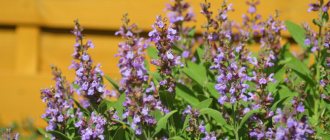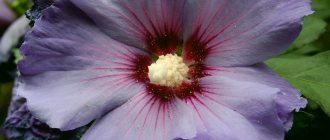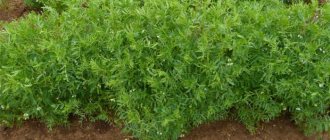- February 24, 2019
- Flowers
- Michael
Many experienced florists know about the speedwell flower, but not everyone has tried to grow it on their own plot. And completely in vain. This is an amazingly beautiful plant that can survive a fairly cold winter without harm and be content with a minimum of care. It is no coincidence that it grows in such harsh places as Altai, the Urals, and Siberia. Therefore, it will not be superfluous to learn more about him.
Description
The plant did not get its name from a beautiful female name. It has Latin roots and consists of two words – vera and unica, which mean “real medicine”. Indeed, it is used in medicine. By the way, Veronica is a relative of the plantain, well known to everyone from childhood, which was actively used in the treatment of minor wounds.
Most varieties are herbaceous. However, there is also a Veronica plant, a photo of which you can see in the article, in the form of small shrubs. Many varieties are perennial; there are relatively few annual varieties.
Externally, the varieties differ greatly from each other - there are tall and low, erect and creeping. The arrangement of leaves can be alternate or opposite.
However, all varieties have one thing in common - the structure of the flowers. The flowers themselves are quite small, but they are collected in a large tube that catches the eye. The color range is quite rich. Although flowers are mainly found in blue and light blue, as well as all their shades, if desired, you can also find white and pink.
After flowering, small boxes containing seeds appear on the tube - they can be collected to be planted next year in a suitable place.
Useful properties and contraindications
The herb Veronica officinalis has anti-inflammatory, analgesic, hemostatic, expectorant and wound-healing effects.
Previously, the plant was widely used in scientific medicine in Russia; now it is used mainly for diseases of the upper respiratory tract and bronchial asthma.
The herb is used in official medicine in Western Europe. In Germany, it is used in the form of tea for respiratory and gastrointestinal diseases, especially diarrhea. In Austria, a decoction is used to treat tracheitis, bronchitis, skin itching in diabetes, and in the treatment of gout.
In Rus', it has long been used for acute diseases of the upper respiratory tract, bronchitis and bronchial asthma, pulmonary tuberculosis, gastrointestinal diseases - decreased appetite, gastritis with low acidity of gastric juice, and diarrhea.
It was used as a diuretic for diseases of the urinary tract and gout, used for rheumatism, diabetes, malignant neoplasms, gynecological diseases, as a hemostatic agent for external and internal bleeding; used for bites of vipers and rabid animals.
Prepared infusion:
1. Pour two tablespoons of dry crushed herbs into 0.5 liters of boiling water, cover, leave for 2 hours, strain. Take in 3-4 doses 20-30 minutes before meals.
The infusion has a strong emollient and expectorant effect, increases appetite, and is used as an anti-inflammatory, analgesic, antiseptic, antitoxic and fungicidal agent.
Externally, the infusion was used for burns, purulent wounds, furunculosis, chronic skin diseases, and sweating of the feet.
The plant was used for eczema, urticaria, neurodermatitis, insomnia, nervous exhaustion, various types of itching, fungal diseases, pyodermatitis.
At the same time, the following infusion was recommended:
2. Pour three teaspoons of dry herb into 3 cups of boiling water, leave covered for 20 - 30 minutes, strain. Take a glass 3 times a day after meals.
The calming properties of the plant are used for headaches, insomnia, and increased nervous excitability, especially during menopause.
For kidney diseases and gout, the juice of fresh Veronica herb is useful:
Take 2 - 3 teaspoons of juice in the morning 20 - 30 minutes before meals, during the summer season.
For chronic pyelonephritis:
Two tsp. Mix herb juice with 1 tbsp. l. goat milk. Take the resulting mixture 2 times a day before meals.
Preparation of alcohol tincture:
Fresh juice can be preserved by preparing an alcohol tincture:
Pour 100 ml of grass juice into 200 ml of vodka, leave in a dark place for 10 days, then strain.
The tincture can be used both pure and diluted, like juice.
It can be used externally to lubricate fungal infections of the skin and scalp.
Preparation and use of oil:
Freshly harvested herbs are infused in an equal weight amount of vegetable oil for 10 days, then the oil is drained and filtered. Used topically for skin burns, festering wounds and boils.
For neurodermatitis and eczema, an ointment was prepared:
Grind 1 part fresh herb with 4 parts pork fat, lubricate the damaged areas.
Veronica has antimicrobial, fungicidal, hemostatic, wound-healing effects, so it is used for external treatment of wounds and skin diseases.
For purulent wounds, ulcers, acne, itchy rashes, and fungal skin infections, baths, rinses, compresses, and lotions are made from the infusion.
Fresh, well-crushed leaves are applied to purulent wounds and ulcers.
In folk medicine, several types of veronica herb are used, which have similar medicinal properties. They belong to the same genus, but are very different in appearance.
Preparing tea:
20 g of herb (2 - 3 tablespoons) are brewed with a liter of boiling water. Drink this dose during the day for all types of skin diseases, eczema, scrofula, gout and rheumatism.
Tea is drunk as a mild diuretic, for sand in the kidneys and bladder, for respiratory diseases, as a good expectorant and thinner for thick mucus.
Let's consider other medicinal species - oak speedwell and longleaf speedwell.
Most popular varieties
In total, today there are about 300 varieties of this plant. Some appeared thanks to the efforts of nature, while others were bred by diligent breeders. We will tell you about several of the most interesting varieties so that a novice gardener can choose the option that suits him.
Great Veronica is the most common wild variety in our country. You can meet it not only in the European part of Russia, but also in Siberia, the Mediterranean, and even Western Europe. Single stems are quite long, up to 70 centimeters. The leaves are located opposite. The flowers are blue or light blue. Very unpretentious. It grows well in almost any soil and tolerates winter frosts without harm. But still loves the sun and moisture. Begins to bloom in early or mid-May. Flowering lasts about 30 days.
Veronica dubravnaya boasts quite large flowers - up to 10 mm in diameter. For a short plant (about 40 cm) this is a very good indicator. The flowers are blue, blue, but also pink. It easily tolerates autumn frosts - even under the snow it does not always shed its leaves. Distributed in Siberia and many European countries.
Speedwell is also not too tall - no more than 40 cm. It has single, pronounced stems. It begins to bloom in June and usually the process drags on for 35-40 days. The color range is quite rich. This variety of Veronica has flowers that can be blue, purple, light blue, pink, or white. It can be found in the wild not only in our country, but also in Western Europe.
General information about the plant
Veronica is a very common plant, varieties of which are presented in different countries of the world. This can be explained by its unpretentiousness and drought resistance, which is why it manages to survive in any climatic conditions. The plant is undemanding to soil, so it feels comfortable both on sandy and clayey soil , as well as on loose and swampy soil. At first it adorned forests, fields and mountains, but after a while it began to be used for decorative purposes for growing in flower beds.
When speedwell became a cultivated plant, it served as the basis for the development of new varieties adapted for ornamental gardening.
However, a person became acquainted with creeping veronica a long time ago, and at that time it was of value to him because of its medicinal properties. There are several hypotheses about the origin of the name Veronica. Perhaps this is due to the Greek word, which translates as “little oak,” or the Latin, which translates to “real medicine” or “genuine plant.” There is also a version that it received its name in honor of Saint Veronica.
Types of speedwell
The genus of this plant is quite numerous and includes more than 300 species . But at the same time, it has very few representatives that can be used for growing in the garden.
However, the varieties bred for such purposes are very unpretentious in care and cultivation. After all, Veronica not only successfully withstands any weather conditions, but also blooms for quite a long time and can grow in various forms. Moreover, among them there are varieties that are most often used for decorative purposes:
Veronica officinalis
- this species can be found in many places. Most of its representatives live in Europe, North America, the Caucasus, Turkey and Siberia;
- Its usual habitats are light, sparse forests. When you first meet Veronica officinalis, you can mistake it for a forget-me-not flower;
- the main feature is that during the process of growth, its stems stretch and intertwine, resulting in a beautiful green mat decorated with blue flowers;
- The plant demonstrates its decorative character when grown in flower beds and paths. Veronica officinalis has ovoid leaves that are slightly stiff and have a short stalk;
- the characteristic color of the flowers is pale blue, although in some species the shade may be white;
- this variety blooms for quite a long time, so it can be enjoyed throughout the summer;
- The main methods of propagation are the use of shoots and sowing seeds.
- A common practice is to sow before winter or spring;
- After sowing, quite a long time must pass - 2 years - before the flowers grow;
- Veronica officinalis can be grown in poor soils and in the shade, and it can successfully withstand long periods of drought.
Veronica Stellera
- under natural conditions, this variety is most common in China and Japan;
- being a low-growing plant, it can grow up to 25 cm, the top is decorated with inflorescences;
- during the growing season it forms straight erect stems with pubescence. The characteristic shape of the leaves is ovate with a jagged edge, reaching 3 cm in length;
- has shortened inflorescences resembling spikelets. In the first weeks of flowering, the spike is dense, but subsequently becomes looser;
- during flowering of this variety, flowers are formed that have a blue or purple tint;
- flowering begins in July and continues until autumn;
Veronica creeping
- the usual habitats of this variety are steppes, meadows and fields of Asia, Siberia and Central Europe;
- creeping shoots form a thick carpet up to 10 cm high, which is decorated with inflorescences of a blue or light blue hue;
- the leaves are ovoid in shape and grow on short stalks;
- What makes the variety unique is that it retains its green color in winter;
- Veronica creeping is an ideal option for decorating rocky gardens and decorative flower beds near ponds;
- the main methods of propagation are sowing seeds or cuttings;
- After sowing the seeds, the plants begin to bloom only two years later. Favorable conditions for propagation by cuttings occur in May.
Planting seedlings
If you decide to plant a veronica flower on your site, planting and care will not cause much trouble. But still, studying the theory will be very useful.
If you want to use seeds (we'll talk about other propagation methods a little later), it would be better to grow them at home first.
First, the seeds are put in the refrigerator for 1-2 months. In mid-March we take them out and get to work. You can plant them either in separate cups or in one common container. The seeds are quite small, but still allow you to plant yourself rather than sow. Try to place one seed in each cup or at 5cm intervals in one container. Otherwise, the plants will interfere with each other and crush each other.
After planting, the soil is watered and covered with film to create a greenhouse effect. The seedlings are kept in a warm, dark place. After the first shoots appear, the film is removed, and the seedlings are placed on the windowsill - the main thing is that there is no cold draft.
When the seedlings acquire 8-10 leaves, they can be planted in the ground.
Veronica flower: description of the plant, characteristics of the main varieties
Veronica is a plant that, along with other flowers, is used in landscape design to decorate areas. There are many varieties of it that have decorative value. Planting and caring for the speedwell plant is not difficult, so any gardener can grow it on his or her own plot.
general description
Veronica has a remarkable appearance - it combines the characteristics of plantain, nettle and bellflower. The peculiarity of this plant is that each of its species has rhizomes that differ in type.
They are superficial filamentous, thick superficial and thin, diverging in a mesh and covering a large area underground. In mature plants of perennial varieties, the root is strong and can withstand winter frosts well.
Annual speedwells have more delicate roots: thread-like, which do not penetrate deep into the soil.
The stem of this plant is long, dense in structure, round in cross-section. It is so strong that you cannot break it with your hands; you need to use a tool. The Veronica leaf resembles a nettle leaf, it is oval in shape, with teeth along the edges and hairs. But speedwell, unlike nettles, does not leave burns if you touch it. The leaf color is predominantly green, but there are specimens with gray leaves.
Veronica flowers
The color of speedwell flowers in nature is bright blue; in cultivated varieties they can be white, lilac, blue, pink, purple. They are small and collected in a dense tall spikelet. The flowers bloom one after another, starting from the bottom, so the total flowering time of Veronica is quite long: when the upper flowers bloom, seed pods are already formed in place of the lower ones. Veronica blooms in May-July.
In the wild, the plant is found in Western Europe, in Russia - almost throughout the entire territory up to Western Siberia. Inhabits forests, meadows, mountain slopes, steppes.
Veronica armena (v. Armenian). A low-growing (up to 10 cm) creeping plant. It has needle-like leaves and blue flowers reminiscent of forget-me-nots.
Veronica caucasica (Caucasian speedwell). The stems and leaves of this species are bright green, with the lower part being darker than the upper part. The leaf is small, elongated, with teeth along the edge. The flowers are painted predominantly in soft colors, lilac or purple, with thin veins of purple color. It grows well in rocky soil and quickly recovers after trampling.
Veronica caucasica (Caucasian speedwell)
Veronica teucrium (v. broadleaf or large). Height up to 0.7 m, erect pubescent stem. The roots are strong and do not freeze in winter. The leaf blade is smooth on top, covered with hairs below. The inflorescence is paniculate, painted in pink, lilac, and blue tones.
Veronica gentianoides (v. gentian). This species has a long flowering period. The leaves of the plant are mainly concentrated at the base, they are silvery-green, with a light edge, the flowers are white with blue stripes.
Veronica surculosa (wood speedwell). This species has a creeping stem and becomes woody in the spring. Cold-resistant perennial plant. Flower color ranges from pink to purple.
Veronica taurica (v. Crimean). Looks good on alpine slides. Loves a mild, stable climate without sudden temperature changes. The flowers are bright blue, the leaves are dark green.
Veronica taurica (v. Crimean)
Veronica filiformis (v. threadlike). The species belongs to the primroses; flowering occurs approximately in mid-April. The leaves are soft green in color, the flowers are light blue.
Veronica incana (v. gray-haired). A distinctive feature of this species is its silvery stem and leaves. The flowers are deep blue.
Veronica peduncularis (v. pedicel). Herbaceous perennial, bush height up to 0.3 m. Blooms profusely, with blue flowers with a yellow center.
Veronica longifolia (v. longifolia). The bush is tall, up to 1.5 m, the stem in the upper part branches into several peduncles. Flowers in lilac-blue tones.
Veronica longifolia (v. longifolia)
Veronica officinalis (v. officinalis). In addition to its decorative value, it also has medicinal value; decoctions and infusions are prepared from it.
Veronica prostrata (v. prostrate). Bush height from 5 to 30 cm. Stems are pubescent, grayish, flowers are pale blue or bluish-lilac.
Veronica anagallis-aquatica (v. key). Bush 0.1 - 1.5 m high, with straight simple or branching stems. The flowers are small, ranging in color from whitish to dirty purple, with a yellow ring.
Veronica jacquinii (v. jacquini). Perennial, forms a bush 0.15 - 0.6 m, blooms in May-August.
Veronica Jaquena (Veronica jacquinii)
Verónica spicata (v. spicate). The bush is from 0.15 to 0.75 cm in height, the stems are simple, strong, green or grayish with pubescence. Forms a thick raceme 5-30 cm long, flowers are blue or bright blue, rarely white, pink, purple.
Veronica siberica (v. Siberian). The bush grows up to 0.4 - 1.5 m. It has strong branching stems, blue flowers are collected in long inflorescences.
Veronica chamaedrys (v. oakwood). A bush with a height of 0.1 to 0.5 m. The stems are creeping, rooting, the flowers are bright blue with dark veins, collected in loose clusters.
Veronica austriaca (v. Austrian). The plant is from 0.3 to 0.7 m tall. Stems are erect or erect. Bright blue flowers are arranged in elongated racemes.
Veronica austriaca (v. Austrian)
Veronica beccabunga (v. flowing). Plant height 0.1 – 0.6 m, erect branched stems. The flowers are often pale blue with blue stripes or dark purple.
In addition to herbaceous forms, speedwells can be shrubby. These are perennials that can be planted not only in a flower bed in the garden, but also placed in portable containers.
Planting and caring for the Veronica plant is not difficult. They are hardy and undemanding and require standard care.
Selecting a location
Veronicas should grow in a sunny area, with light throughout the day. In partial shade, and even more so in the shade, plants will not be able to fully display all their decorative qualities.
Soil requirements
Speedwells can grow on any soil: sandy, loamy, even rocky. Acidity can be neutral, slightly acidic or slightly alkaline. It must be well-groomed; plants do not have any special nutritional requirements.
Required watering
Different types of this flower need different amounts of moisture. Herbaceous speedwells with thin creeping stems do not tolerate drought well, stop blooming and may dry out. Species with strong, erect stems tolerate moisture deficiency much better. In this regard, it is necessary to water veronicas in accordance with the requirements of a certain type, and not with the same frequency and not in the same volume.
Fertilizing
Speedwells growing on fertile soils do not require fertilizing. Plants need to be fertilized only if they grow in poor soils. They are fed during budding and flowering. They mainly use organic matter: humus, ash, herbal infusions.
Wood ash for feeding flowers
Plants with tall stems are tied to supports so that they do not break from the wind. In autumn, the stems are cut off and the roots are covered with warm mulch material.
There are several methods for propagating veronica that can be used when growing at home.
Seeds
This is the most labor-intensive option, but it allows you to obtain plants that have retained the characteristics of the variety and are free from diseases. It is also used if you need to quickly increase the number of flowers. The seed method involves growing seedlings and then transplanting them to a permanent place. It is also possible to simply sow the seeds directly into the ground in autumn or early spring.
Before sowing seeds for seedlings, they are stratified for a month. Sow in containers (at intervals of 5-7 cm) or pots in March. Young plants are planted in flower beds when they have 8-10 leaves.
Cuttings
To obtain planting material, cuttings are taken from healthy plants. They must be at least 10 cm long. The shoots are placed in water (a root formation stimulator can be added) for rooting. You can root cuttings in wet sand. They are planted in the flowerbed in August so that they have time to take root before winter.
Veronica cuttings
Dividing the root
This is the easiest way to propagate perennial veronica. All you need to do is dig up a bush, divide it into 2 or several sections and plant it separately. Veronicas are replanted in the fall.
Veronica is considered a hardy plant, therefore it is rarely affected by diseases. However, flowers growing in the shade and in moist soil can develop downy mildew. Treatment with fungicides will help against the disease.
In addition to this disease, speedwells can be affected by ring spot, which is carried by nematodes. The diseased plant will have to be destroyed. Prevention is the introduction of nematicides into the soil.
Among the pests that can settle on Veronica are moths, cutworms, and moths. Treatment with insecticides will save you from them.
Beneficial features
Veronica officinalis is used in traditional medicine as an anti-inflammatory and expectorant for gastrointestinal diseases, in folk medicine - for pulmonary pathologies, inflammation of the bladder, stomach and kidneys, diseases of the adrenal glands, headaches, rheumatism, and to stimulate appetite. Externally used for burns, wounds, skin diseases. Speedwell is used in food as a substitute for watercress, adding it to salads, soups, and also as a side dish for fish and meat.
Veronica dubravnaya
The large number of colors and shapes of the plant allows gardeners to use it in a wide variety of variations: place it in flower beds in combination with other decorative flowers, along paths, near buildings, on alpine hills, and grow in pots or containers. Veronica looks good next to large, brightly colored flowers: roses, peonies, tulips, etc.
Speedwells are used to decorate a garden plot along with many other flowers. This is a completely unpretentious and hardy plant that does not require special care and is characterized by long and bright flowering.
- When choosing a place for planting, taking into account the light-loving nature of the crop, choose an open and sunny area. Light partial shade is also possible.
- Veronica can grow on almost any soil, preferably light and loose loam. One of the main conditions is good soil drainage and the absence of stagnation of moisture in the area. Ordinary crushed stone can be used as drainage. Soil with a neutral or slightly acidic reaction is the best option for the plant.
- A drought-tolerant plant, speedwell tolerates short periods of drought better than excessive moisture. Excess or constant stagnation of moisture can be detrimental to the crop.
- A hardy and resilient plant, it is even resistant to trampling. If you step on veronica bushes, they quickly recover and raise their leaves.
- Veronica seeds are sown in open ground in the second half of autumn, when the soil is not too cold and frost has not set in. The depth of planting seeds in grooves or holes is small, about 5 mm. The approximate interval between seeds is 30 cm. As they grow, the next year, the seedlings are planted, leaving a larger interval (50 cm).
- You can sow Veronica seeds in early spring in boxes for seedlings. In this case, preliminary stratification (hardening) of the seed material will be required. To do this, the seeds are placed on a moist soil mixture (peat and soil), sprinkled with earth and covered with a film with holes. The container is placed in a cold place (refrigerator, cellar) for 3 weeks. After low temperatures, the container with the seeds is placed in a warm and bright place. After 2 weeks, the first seedlings appear. Seedling care is usual: watering, light, ventilation and heat (about 150C).
- In any case, the seedlings will bloom only in the second year of life.
- When planting Veronica seedlings in open ground, leave a distance of about 50 cm between plants, taking into account the future growth and branching of the bushes.
- Planting seedlings in a flower bed is carried out in the spring in previously prepared soil (fertilizer, drainage, loosening).
- Holes or grooves are dug shallow, according to the size of the root system of the seedlings.
- The planting site is spilled with water and the plants are planted in the ground.
- A beautiful landscape plant, speedwell is widely used for decorating flower beds, landscaping park areas, ponds, and designing mixborders or rockeries. Slender, straight shoots of Veronica with compact spike-shaped inflorescences serve as an ideal background for low-growing or ground cover plants. The flower stalks of the plant are used for cutting; they last a long time in the bouquet. When planted, Veronica spica goes well with carnations, geraniums, sedums, saxifrage, and knotweed.
- In addition to its decorative value, speedwell is a well-known medicinal product. It is used as a wound-healing, detoxifying (for snake bites) remedy. Herbal decoctions are used in the treatment of influenza, bronchitis, and respiratory diseases. Externally, an infusion of the herb is used for various skin diseases, ulcers, fungal diseases, abrasions and cuts. This is due to the anti-inflammatory, analgesic, healing and antibacterial properties of the flower. Before using any folk remedies, including those involving Veronica spica, you must consult a doctor.
- Veronica spica is a valuable honey crop that attracts bees.
Preparing for landing
As you can see, the initial stage of growing a veronica flower does not cause much trouble. Now you can move on to the next step - planting in the ground.
Before this, the seedlings are accustomed to being kept outside. The easiest way to do this is by starting to take the container out onto the balcony in mid-late April, starting with the hottest hours. First for an hour, the next day for two. As a result, after two weeks you can safely leave the seedlings on the balcony around the clock.
Plants are planted in the soil when it has warmed up sufficiently. It would be a good idea to add mineral fertilizers, primarily phosphorus. It promotes the formation of a powerful root system and significantly speeds up the rooting process. This means that the plant will develop faster and will soon delight you with gorgeous flowers.
Sowing in the ground
Some gardeners who do not want to spend too much time caring for and planting speedwell plants prefer to plant the seeds directly into the ground.
There may be two options here - autumn and spring planting. Each of them has certain characteristics.
First of all, you need to choose a suitable location. Veronica loves open areas rich in sun. It is not afraid of wind and excessive heat, especially if you regularly water the flowerbed.
If you prefer to plant seeds in the spring, then they must first be stratified. The easiest way to do this, as mentioned above, is to put a paper bag with seeds in the refrigerator for a couple of months. In flower beds, you shouldn’t deepen them too much - just sprinkle them with a couple of centimeters of soil so as not to further complicate germination.
When planting in autumn, the seeds are planted directly into the ground - they do not need additional processing, because over the winter the soil will freeze and stratification will occur naturally.
The distance between the holes should be at least 10-15 centimeters. Otherwise, the grown plants will crush each other - the weak ones will die and the strong ones will weaken.
Photo of Veronica in landscape design
Due to its ease of care and beautiful appearance, the flower is often used to decorate alpine slides and rockeries. Veronica is also an indispensable part of mixborders. Bushes look good near ponds and borders.
Veronica looks beautiful with buzulnik, highlander and bergenia. The flower is also planted together with daisies of different shades. The composition with rose bushes is no less beautiful.
Thus, both types of plants complement each other and seem brighter and more elegant.
Planting Veronica in a mixborder - video
Reproduction by division
There are other ways to propagate the Veronica flower. For example, division is popular among florists.
Most varieties of speedwell are perennial, so you can take ready-made bushes rather than seeds. Dividing is allowed in late April - early May (before flowering), but it is better in the fall, before wintering.
To do this, select a large bush, carefully dig it out of the soil and divide it into two parts using a garden knife. Then transplant both seedlings to a suitable location. It is advisable to fill the holes with compost, black soil, or simply fertilize them with phosphorus fertilizers.
After transplanting, cover the bush, protecting it from wind and excess sun - the latter is especially dangerous. Without a developed root system, the plant may simply dry out. After ten days, the covering material can be removed - usually during this time the plant acquires a powerful root system. Further care is as simple as possible - just regularly water the flowerbed and loosen the soil.
Propagation by cuttings
Another reliable way to get a new plant is to use cuttings. Usually cuttings are carried out in mid-August. A shoot is cut off from a healthy, strong plant with the desired characteristics. The optimal length is 10-12 centimeters.
Now it needs to be allowed to germinate. Some prefer to germinate cuttings in water, while others keep it in a root solution for half a day, and then transplant it into nutrient soil. In the latter case, you need to cover the pot with a plastic bag, creating a greenhouse effect.
After a couple of weeks, when roots appear, the cutting can be moved into open ground. If you used soil rather than water for germination, then it is advisable to replant the plant with it in the flowerbed.
Before the first frost, the plant will have time to take root and will delight you with gorgeous flowers in the spring.
Care
As you can see in the photo, Veronica flowers are very beautiful and elegant. But for them to be like this, you will have to try, spend time and effort on caring for them.
Fortunately, in general the plant is quite unpretentious. It feels great in sunny places and in partial shade, and is not afraid of wind and excessive heat. Most varieties are drought-resistant—they don’t even need to be watered! The only exception is the flowering period. Lack of moisture will cause the flowers to fall off. However, if it rains heavily at least once a week, then you won’t have to water it manually.
When flowering is complete, you need to wait a couple of weeks and trim the stems. New ones will appear quite quickly - the set of green mass is very rapid. But after a few weeks of dormancy, the root system will become more powerful, which will have a positive effect on the life of the plant and its frost resistance.
Herbs in medicinal plant collections
The herb is part of effective medicinal preparations and breast tea.
Veronica, like the series, is one of the main remedies used in preparing baths for infants with diaper rash, as well as baths for the treatment of scrofula and itchy dermatitis.
Infusion from a collection of herbs:
- Seed grass – 1 part
- Veronica – 1
- tricolor violets – 1
Mix crushed dry herbs, pour one teaspoon of the mixture with a glass of boiling water, leave for 30 minutes. Take 1 glass 3-4 times a day after meals. From this collection you can prepare a bath infusion.
For acne and skin rashes, infusion:
- Bedra ivy herb – 1 part
- Veronica – 1
One tbsp. l. pour a glass of boiling water over the mixture, boil for 10 minutes, leave for 2 hours. Use for washing and lotions.
For gout, collection with veronica:
- Burdock root – 3 parts
- wheatgrass rhizome – 2
- violet grass – 3
- Veronica – 2
Pour one tablespoon of the mixture into a glass of boiling water, boil for 10 minutes, leave for half an hour. Take half a glass 4 - 5 times a day 30 - 40 minutes after meals for gout.
Contraindications:
- Individual intolerance
- Take with caution for gastritis with high acidity
- Use with caution for hypotension
When treating with medicinal herbs, for your health, you should always consult with your doctor.
Watch a short video:
Veronica herbs are spring-summer honey plants; from 1 hectare they produce up to 18 kg of healing fragrant honey.
Dangerous pests
Veronica is usually not attacked by pests, but sometimes you have to fight them.
The most common problem is the attack of caterpillars - they simply eat young shoots and foliage. The problem can be solved by timely weeding, warming the soil and stopping watering.
Flowers are attacked much less frequently by cutworms, long-whiskered moths and moths. The problem is usually solved by treating the bushes with suitable insecticides.
Accustomed to life in the wild, Veronica easily resists infections. However, due to lack of sun and excessively moist soil, a gray coating may appear on the leaves - downy mildew. To cure the plant, a special fungicidal solution is made. For this you can use drugs such as “Gamair”, “Fitosporin”. Usually one single treatment will completely solve the problem.
Medicinal properties of Veronica officinalis
Substances contained in medicinal speedwell have the following types of effects when they enter the body:
- anti-inflammatory;
- antimicrobial;
- antitoxic;
- antitussive;
- bronchodilator;
- analgesic;
- hemostatic;
- fungicidal;
- hepatoprotective;
- antitussive.
This is not a complete list of the beneficial properties of Veronica officinalis. It has anticonvulsant and anthelmintic effects. For problems with the digestive system, the herb is used as an astringent, helps reduce acidity, and improve the absorption of nutrients.
The plant also affects carbohydrate metabolism. When infusions and decoctions of this herb are included in the diet, metabolism improves, appetite increases, and the secretion of gastric juice is stimulated.
Infusions and decoctions from the plant are used for treatment:
- respiratory tract diseases, incl. chronic;
- dermatitis;
- headache;
- gastritis;
- initial stage of ulcerative lesions of the gastrointestinal tract;
- rheumatism;
- fungal skin infections.
We recommend reading: Beneficial properties of autumn crocus and contraindications
They recommend medicinal veronica for problems with the liver, kidneys, and gall bladder. As an external remedy, it is used to treat boils, burns, and festering wounds.
The herb has a positive effect on the nervous system. It is recommended for patients with anxiety disorders, insomnia, problems with memory and concentration.











